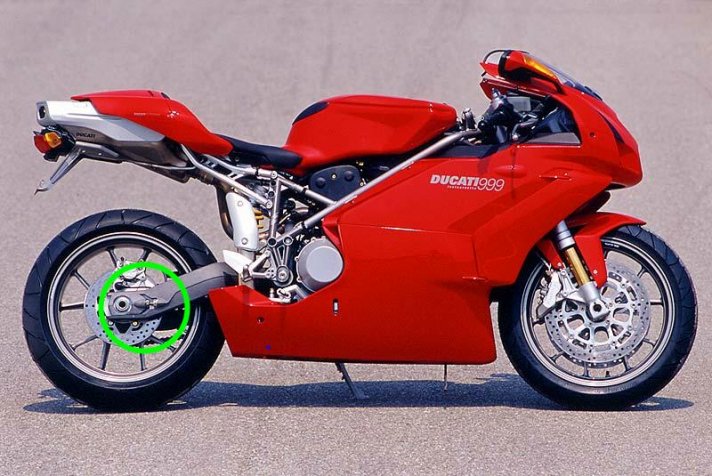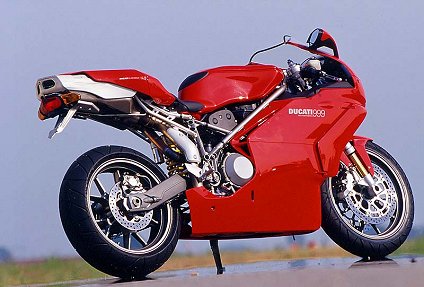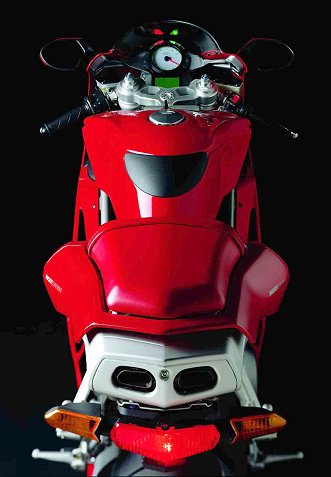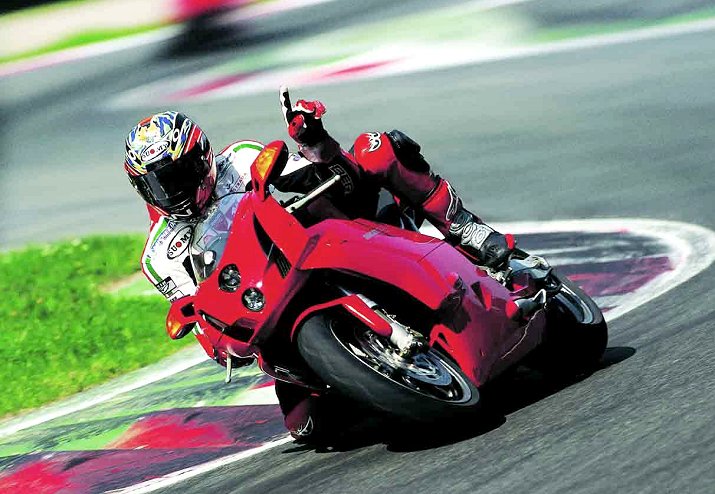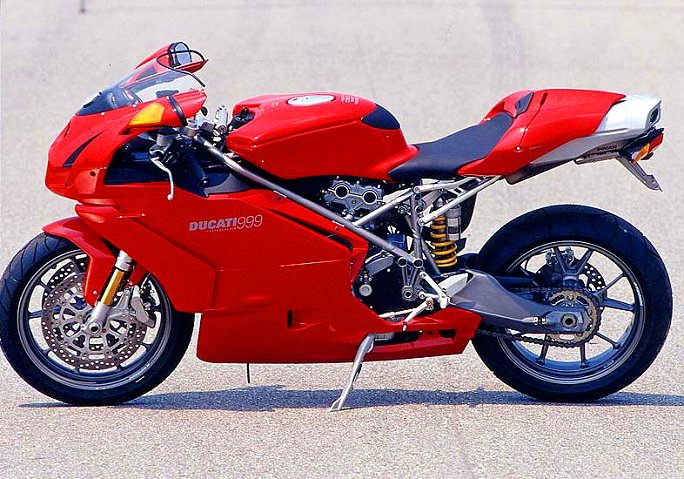
Designing the successor to one of the most beautiful and successful motorcycles in history, the Ducati 916/996/998, has undoubtedly been a daunting task for Ducati. A year or two late (depending on whose version you listen to), Ducati finally announced the 999 as its new production-based superbike model.
The 999 succeeds the 916/996/998 chassis that dominated superbike racing for a decade (and continues to dominate superbike racing in the hands of Troy Bayliss and others). Not surprisingly, Ducati claims to have taken great care in designing the chassis and weight distribution in order to optimize handling. The stock bike also comes with one degree of adjustment in the fork rake (which also changes trail over a range of six millimeters).

The ergomonics are also adjustable, including footpegs and a seat/tank unit that slides fore and aft (on the single seat version).
Of course, the 999 features a trellis frame and a version of the Testastreta V-twin engine currently powering the 998 superbike. Engine changes include a new exhaust system, intake system, fuel injection system and engine management system.
Gone is the single-sided swingarm in favor of a double-sided unit that has a unique, perfectly horizontal section covering the range of chain (and wheelbase) adjustment, which is circled in the picture below.
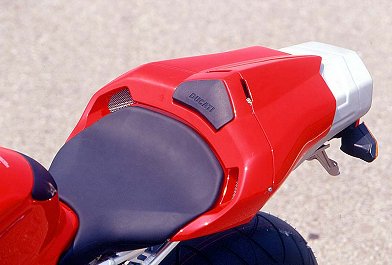
By the way, rider ergonomics are dramatically improved by a 15mm lower seat and a 10mm reduction in the distance between the seat and the handlebars. The 999 also features a 15mm longer swingarm (a popular design element in modern sportbikes).
Ducati claims the 999 is also a “triumph of rationalization”, which includes 30% fewer parts, easier access for maintenance purposes, and longer maintenance intervals. Ducati describes the goals for the design of the 999 as follows: “Our goal was to create a Ducati superbike that improves rider ergonomics, makes maintenance easier, reduces machine complexity, and of course, offers performance second to none.”
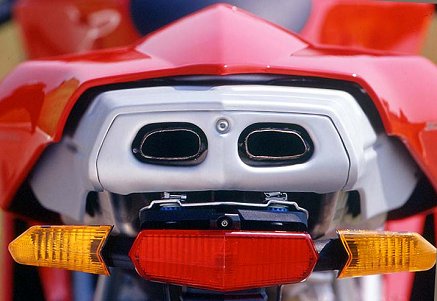
Overall, the 999 is much thinner, with a reduced frontal area (for dramatically improved aerodynamics, but significantly increased rider comfort). Below we have an interview with engineer Andrea Forni, head of the Ducati vehicle testing department, regarding the Ducati 999, followed by some quotes from Ducati’s World Superbike riders, Troy Bayliss, Ben Bostrom and Ruben Xaus, regarding their thoughts on the 999.
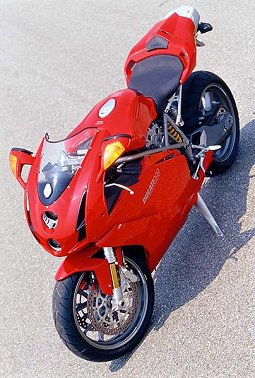
How would you describe the dynamic characteristics of the Ducati 999 compared to the traditional handling of the models produced by Ducati?“The dynamic response of the Ducati 999 reflects the tradition of the Bolognese motorcycling manufacturer in the field of sports motorcycles, and moreover improves some of the features that have won the fame of our Superbikes over the decades.
First of all, the directional stability is at peak levels, giving the rider the reassurance of solid, safe steering, even in the most critical sport riding conditions on the track or road. On uneven stretches taken at top speed, around curves on the track or highway at full momentum and down hills at maximum throttle, the front of the bike obeys with exemplary precision the direction decided by the rider. This without triggering steering oscillations, an undesirable side effect of the “extreme” chassis of many late generation sport bikes selected for maximum agility, even to the detriment of stability.”
What were the basic design choices of the Ducati 999’s frame and chassis?
“Our new Superbike maintains that unique stability that all Ducati’s have, but it also improves some basic requirements of the super sport motorcycles thanks to specific design decisions. These include: (1) lowering the rider’s seat level by 15 mm;
(2) lengthening the swing arm by 15 mm; (3) reducing the distance between the seat and handlebars by 10 mmWas lowering the seat level done just to improve comfort?
This modification was not made, as one may think, just to achieve greater comfort; it significantly influences the dynamic response of the vehicle as well.
In fact, lowering the rider’s seating level, implies lowering the whole center of gravity, which is significantly affected by the position the rider assumes on the motorcycle.”Why does the special positioning of the center of gravity on the Ducati 999 greatly improve its dynamic response?
“In the first place, lowering the center of gravity produces a reduction of the shift in load during braking and acceleration. The result is a smaller tendency of the bike to pull up when accelerating violently (which reduces the performance during acceleration at lower gears), while the rear wheel tends less to lift during intense braking (limit to the decelerations of the vehicle).”
Does the swingarm length affect stability during braking and acceleration of the Ducati 999?
Definitely. A longer swingarm produces a variation in how the static loads are divided up on the wheels, increasing the share of weight weighing on the front and therefore limiting the pull upwards. So the excellent torque delivered by the Testastretta can be maximized even in the lowest gears without the front wheel losing contact with the ground too easily. The rider will always be guaranteed the greatest cohesion with his course. A long swingarm also improves the stability when braking because it increases the bike’s wheelbase (distance between the front wheel shaft and the rear wheel shaft). This increase ensures a reduction in the shift in load when accelerating strongly. In fact, the loss of grip of the rear during hard braking is countered by the limited transfer of load, although a good part of the weight is concentrated in the front of the Ducati 999. As a result, the motorcycle doesn’t “wag.”
What are the parameters that assure the superb handling of the Ducati 999?
Lowering the whole center of gravity of the rider-motorcycle unit has beneficial effects on handling as well. In fact, the Ducati 999 is a motorcycle that bends over with little effort and extreme rapidity, demonstrating an enviable pace, even on the most tortuous stretches.
But how can handling and stability co-exist?
The modifications described above were obviously “calibrated” in order to enhance the benefits without encountering the natural contraindications. For handling purposes, the potentially negative effects due to the increase in the wheelbase are widely compensated for, and exceeded, by lowering the center of gravity.
In addition, getting the rider closer to the center of gravity also reduces the moment of total inertia of the “rider-bike” assembly with respect to the roll axis, making the variations of the bike’s tilt faster and making it possible to take curves in rapid succession at high speeds and with minimum effort.But didn’t all these modifications to improve the dynamic response of the Ducati 999 negatively affect riding comfort?
“Lowering the seat level reduces the tilt of the torso with respect to the vertical and consequently the load weighing on the rider’s wrists. A very similar result is obtained through limiting the seat-handlebar distance. In this case, too, a part of the weight of the rider’s torso is shifted from the wrist to the pelvis. The overall result is less fatigue on the arms, with clear benefits on comfort, allowing a better and constant physical condition of the rider, indispensable for extreme riding.”
How does the shape of the fuel tank influence riding comfort?
“The shape of this component is extremely important. At the point where the abdomen rests, the tank is lower. This allows the rider to assume a perfect alignment with the bike in the most natural, less fatiguing way. Similarly speaking, its limited width in the area where the thighs are inserted allows the legs to find the most comfortable position possible. But since every effort to obtain the ideal riding position sooner or later comes up against the morphological differences between individuals, the Ducati 999 presents highly advanced ergonomic solutions. On the new Ducati Superbike, the rider can adjust, according to his riding style and physical structure, all parameters of the chassis (rake, height of rear), suspension (spring preload, rebound damping, compression damping of front and rear) as well as the position of the foot pegs (lengthways and in height) and the seat (lengthways on the single-seat version). The goal of the ergonomic adaptability is one of the greatest results achieved with the Ducati 999.”
Pilots’ impressions:
Troy Bayliss“I liked the riding position, you feel quite protected by the mirrors because they have been put in a position to fit right in front of your shoulders. So any guys out there who are going to have a 999 are really going to enjoy riding it.”
Ben Bostrom
“It was so nice for a sport-bike. The seat was lower and the handlebars higher and it had a comfortable seating position. In addition it was a very slim bike and this is good for your knees.”
Ruben Xaus
“The 999 is great, I already tested the standard 996 and the 998R and the new bike is much more stable in the braking points, it appears to have much more grip and it really looks like a Ducati.”
“The Testastretta engine is the same, it gives the same style of riding but it seems easier to ride and I really like it a lot.”
“Ducatis are always nice to look at. When new models come out, you are so used to seeing the old one, but see this one a few times and you will love it. It looks more futuristic, but the chassis is more stable and the bike is easier to ride. The 999 is as good as before but a lot of improvements have been made in the design”.
